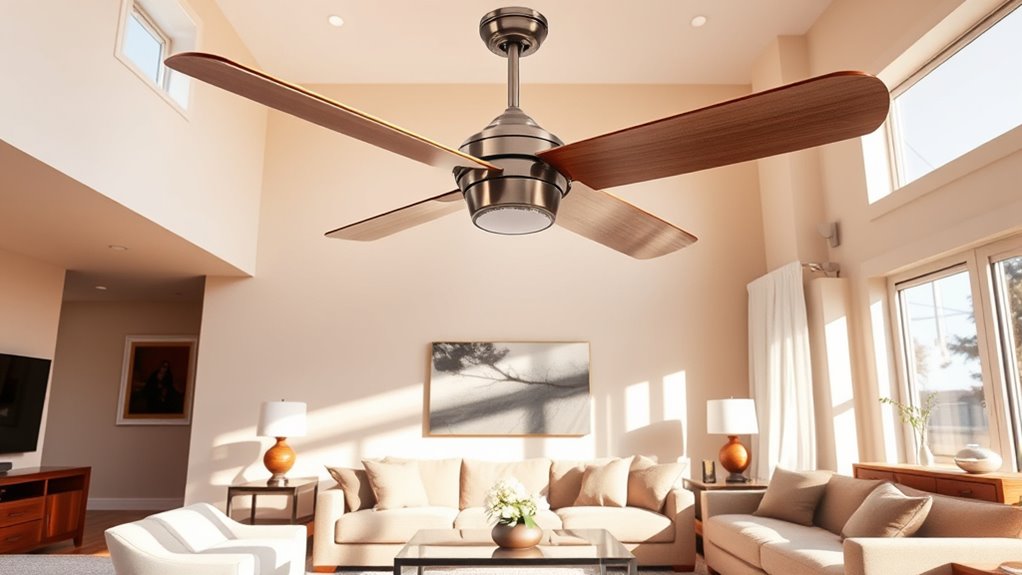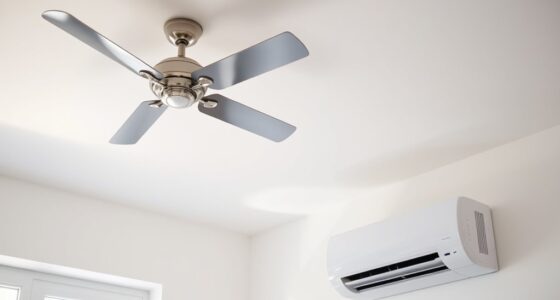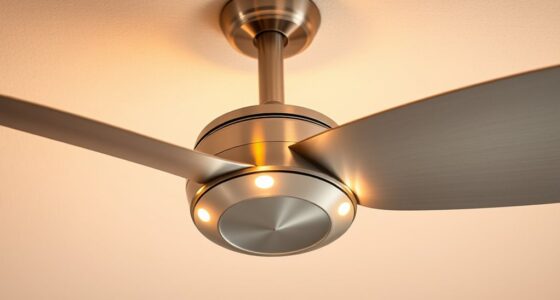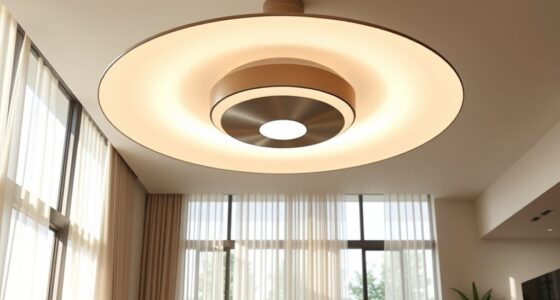To determine the right ceiling fan size, first measure your room’s length and width with a tape measure. Multiply these to find the square footage. For small rooms under 75 sq ft, choose fans with 29-36-inch blades. Moderate spaces up to 225 sq ft need 42-48-inch fans, and larger rooms over 225 sq ft require 52 inches or more. Proper sizing guarantees efficient airflow and comfort—continue to explore these tips for perfect installation.
Key Takeaways
- Measure your room’s length and width with a tape measure to calculate square footage.
- Multiply length by width to determine the room size, guiding fan blade span selection.
- Use under 75 sq ft as a guide for fans with 29-36 inch blades; larger rooms need bigger fans.
- For rooms over 225 sq ft, choose fans with 52 inches or more for effective airflow.
- Proper measurement ensures you select a fan that provides optimal circulation and energy efficiency.
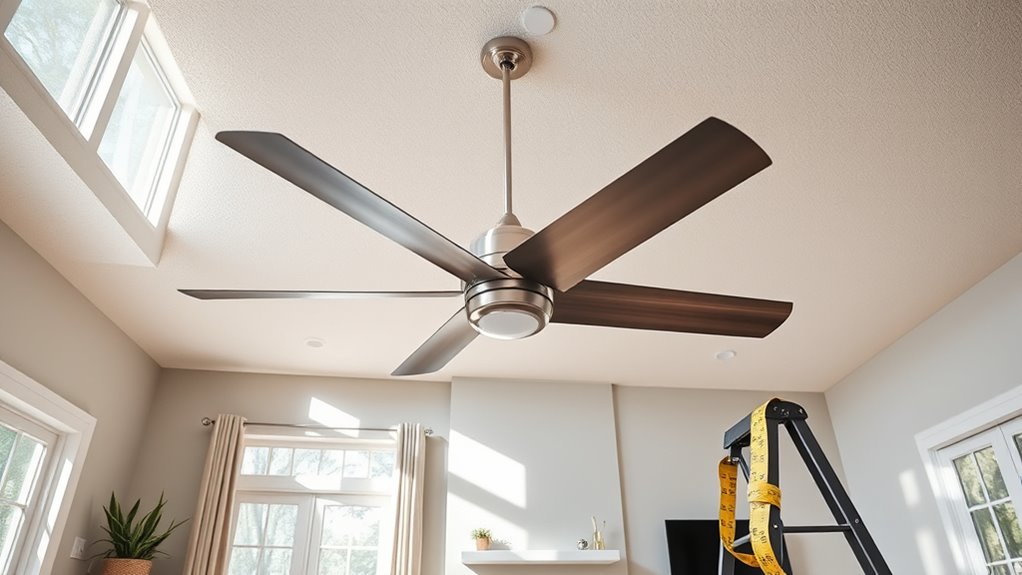
Have you ever wondered how to choose the right ceiling fan size for your space? Picking the correct size isn’t just about aesthetics; it directly impacts energy efficiency and how effectively your fan cools or circulates air. To get it right, start by measuring your room’s dimensions carefully. Use a tape measure to find the length and width of the space, then multiply these numbers to get the square footage. Generally, smaller rooms under 75 square feet benefit from fans with a blade span of 29 to 36 inches, while larger rooms—say, up to 225 square feet—do well with fans that have a 42 to 48-inch blade span. For even bigger spaces, like living rooms over 225 square feet, consider fans with 52 inches or more. Choosing a fan that’s too small for the room can lead to inefficient airflow, making your AC work harder and increasing energy costs, while an oversized fan might create too much noise or feel overwhelming. Proper appliance maintenance can also ensure your fan operates efficiently over time.
Once you’ve identified the appropriate size, focus on installation tips that enhance energy efficiency. Proper mounting height is essential—install the fan so that blades are about 8 to 9 feet above the floor for maximum airflow. If your ceiling is higher, you might need a downrod to maintain this clearance. Ensuring the fan is balanced and securely mounted minimizes vibrations and noise, which keeps the airflow steady and your energy use efficient. When selecting your fan, look for models with energy-saving features like reversible motors, LED lighting, or smart controls that allow you to adjust the fan’s speed based on your needs, reducing unnecessary energy consumption. Additionally, pay attention to the fan’s airflow efficiency—measured in CFM (cubic feet per minute). A higher CFM rating indicates better airflow, but it doesn’t mean you need the largest fan for your space. Choose a fan with an appropriate CFM for your room size to avoid wasting energy. Using ceiling fans in conjunction with your air conditioning can considerably cut down on energy bills—just make sure your fan size is right so it complements your cooling efforts without overworking your system. Proper installation, including correct blade pitch and secure mounting, ensures maximum efficiency and comfort.
Frequently Asked Questions
Can a Larger Fan Be Too Powerful for a Small Room?
A larger fan can sometimes be too powerful for a small room, causing excessive airflow and noise. You might notice increased fan noise and higher energy consumption, making it less comfortable and more costly. To avoid this, choose a fan size that matches your room’s dimensions. When you pick the right size, you’ll enjoy efficient cooling without unnecessary noise or energy use, ensuring a comfortable, quiet environment.
How Do Ceiling Fan Sizes Vary by Ceiling Height?
Ironically, your ceiling height actually guides your fan size choices. For low ceilings, you want a smaller fan to avoid hitting your head and to keep proportions balanced. Conversely, tall ceilings call for larger fans to distribute air effectively and match room proportions. You should measure your ceiling height carefully and choose a fan that complements the space, ensuring comfort and proper airflow without overwhelming the room’s design.
Is It Necessary to Consider Room Shape When Choosing Fan Size?
You should consider room shape when choosing fan size because it affects fan placement and airflow. Irregular or long rooms may need multiple fans or larger units to guarantee even cooling. Pay attention to how the Fan placement impacts air circulation, especially in uniquely shaped spaces. By matching fan size to your room shape, you optimize comfort and efficiency, making sure the airflow reaches all areas effectively.
Do Different Fan Blade Materials Affect Size Recommendations?
Different fan blade materials can influence size recommendations because of blade durability and material maintenance. For example, lightweight plastic blades may be easier to clean and maintain but might not be as durable as metal or wood blades. When choosing a fan, consider how the material impacts longevity and upkeep. While size primarily depends on room dimensions, selecting the right blade material guarantees your fan stays efficient and looks good over time.
How Often Should I Update My Ceiling Fan Size for Remodeling?
Think of your ceiling fan as a trusty companion that needs a wardrobe update after a big change. When you remodel, it’s wise to reassess your fan size to guarantee ideal airflow and energy efficiency. Usually, update your fan during major renovations or every 5-10 years, considering fan maintenance and efficiency. This keeps your space comfortable and your energy bills in check, just like keeping your wardrobe fresh and functional.
Conclusion
Choosing the right ceiling fan size guarantees comfort and safety in your space. By measuring your room accurately, you can select a fan that circulates air effectively without overwhelming the room. Remember, isn’t it worth taking a few extra minutes now to enjoy perfect airflow and energy efficiency later? Don’t underestimate the power of the right-sized fan—your comfort depends on it. So, are you ready to find the perfect fit for your room?
